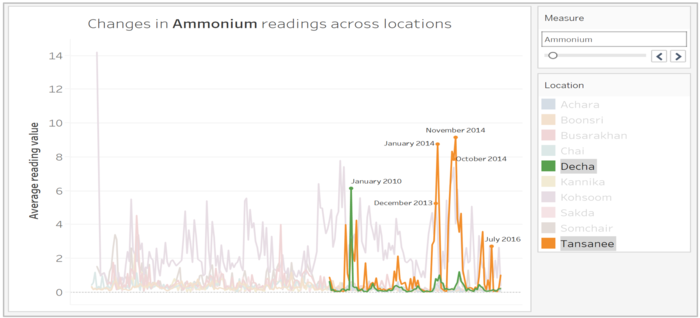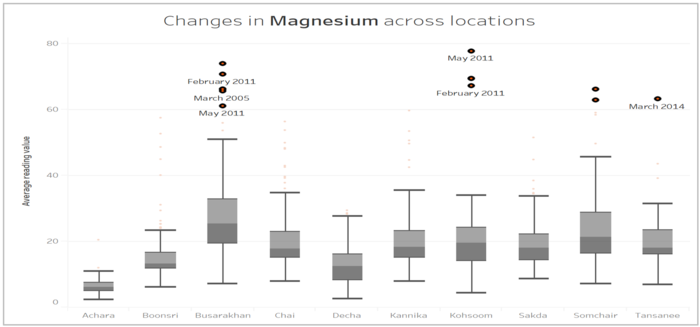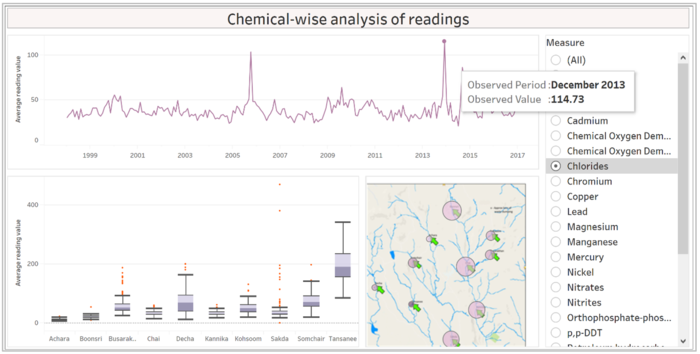Difference between revisions of "ISSS608 2017-18 T3 Assign Harisingh Q2"
| Line 31: | Line 31: | ||
:* Few chemicals have missing readings only in recent years, the potential period for dumping. | :* Few chemicals have missing readings only in recent years, the potential period for dumping. | ||
:* Inconsistent number of readings of a chemical across locations, leading to location-specific sparsity in data. | :* Inconsistent number of readings of a chemical across locations, leading to location-specific sparsity in data. | ||
| − | :* For Achara, Decha, and Tansanee, readings have only been collected in recent past (2009 | + | :* For Achara, Decha, and Tansanee, readings have only been collected in recent past (2009 onward). It would have helped to understand the overall pattern since 1998 in these locations. |
With a solid background on data sampling, we will next focus our attention on remaining chemicals and try to understand '''anomalies''' in form of unusual patterns in actual readings. | With a solid background on data sampling, we will next focus our attention on remaining chemicals and try to understand '''anomalies''' in form of unusual patterns in actual readings. | ||
| Line 46: | Line 46: | ||
===Dashboard for Analyzing Changes in Readings=== | ===Dashboard for Analyzing Changes in Readings=== | ||
| − | For remaining chemicals, investigators can use the below dashboard to '''interactively analyze''' change in actual readings and/or compare their readings across locations. Even though '''Chlorides''' has high number of sample collected for '''Boonsri, Chai, Kannika, and Sakda'''(indicated by bubble size in location map), it observed very high reading in '''Tansanee'''(indicated by | + | For remaining chemicals, investigators can use the below dashboard to '''interactively analyze''' change in actual readings and/or compare their readings across locations. Even though '''Chlorides''' has high number of sample collected for '''Boonsri, Chai, Kannika, and Sakda'''(indicated by bubble size in location map), it observed very high reading in '''Tansanee'''(indicated by color shade). |
| + | |||
| + | [[File:h_chart15.png|700px]] | ||
===Dashboard for Analyzing Peaks in Readings=== | ===Dashboard for Analyzing Peaks in Readings=== | ||
Revision as of 04:16, 9 July 2018
In the previous sections, we consolidated our understanding in different aspects for given problem. We started by identifying key data collection issues, followed by trend analysis of number of samples collected for different chemicals. In the process, we also filtered chemicals of interest for further analysis.
Here is a summary of key issues in data sampling, which requires special attention from Hydrology Department in the future:
- Most chemicals have missing readings for many years, leading to sparse data.
- Few chemicals have missing readings only in recent years, the potential period for dumping.
- Inconsistent number of readings of a chemical across locations, leading to location-specific sparsity in data.
- For Achara, Decha, and Tansanee, readings have only been collected in recent past (2009 onward). It would have helped to understand the overall pattern since 1998 in these locations.
With a solid background on data sampling, we will next focus our attention on remaining chemicals and try to understand anomalies in form of unusual patterns in actual readings.
The below line chart clearly shows that Ammonium observed highest concentration in two locations, namely Decha and Tansanee, in years 2010 and 2014 respectively.
The box plot gives us more insights into concentration of individual chemicals in different locations. Magnesium seem to have experienced higher readings in Busarakhan and Somchair, with most of peaks observed around May 2011.
Dashboard for Analyzing Changes in Readings
For remaining chemicals, investigators can use the below dashboard to interactively analyze change in actual readings and/or compare their readings across locations. Even though Chlorides has high number of sample collected for Boonsri, Chai, Kannika, and Sakda(indicated by bubble size in location map), it observed very high reading in Tansanee(indicated by color shade).



